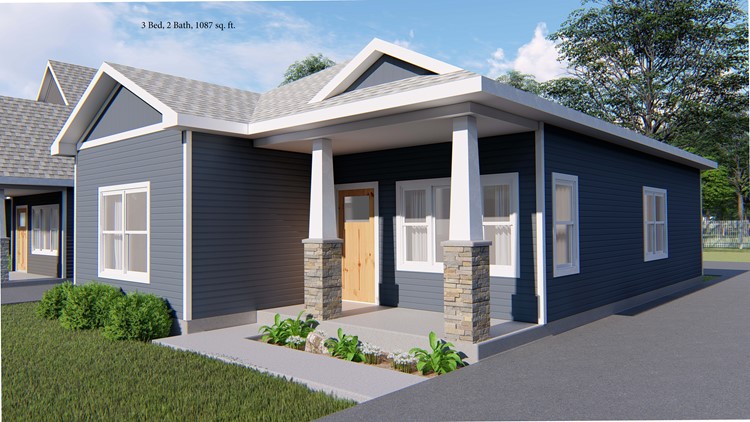GRAND HAVEN, Mich. — (GRBJ) - The city of Grand Haven, in partnership with Housing Next, reduced barriers to the creation of housing at all price points with recent updates to its zoning ordinance and approval of a first-of-its-kind housing development in West Michigan.
The new zoning ordinance was approved by the Grand Haven City Council in January and is aimed at improving housing choice and supply across the city, promoting greater mobility choices for residents, providing more equitable access to wealth creation and streamlining the zoning approval process for developers, among other key changes.
The project, dubbed Robinson Landing, brought together the city, nonprofit developer Michigan Community Capital, the Ottawa County Land Bank and the Grand Haven Area Community Foundation to ensure new homes are affordable for households that earn less than 80% of the area median income (AMI).
Robinson Landing will include approximately 32 single-family housing units on 7.58 acres of vacant land on the north side of Comstock Street in Grand Haven.
The land was owned by the city and transferred to the Ottawa County Land Bank Authority last fall to prepare the site for redevelopment. Michigan Community Capital will buy the property later this year.
About half of the homes will be sold to households that earn between 60% and 80% AMI. In Ottawa County, that is between $35,160 and $83,600 a year. These homes will be sold at approximately 75% of the appraised value and will be on a 99-year ground lease with the city’s newly created community land trust. There will be restrictions on the resale, which will ensure long-term affordability of these homes.
The remaining homes will be sold at market rate without any income or resale restrictions.
The neighborhood will have a mix of homes that range in size to support various incomes and household sizes. Housing types will be a mix of 840-square-foot one-story with two bedrooms and one bathroom, 1,087-square-foot one-story with three bedrooms and two bathrooms and 1,421-square-foot two-story with three bedrooms and two-and-a-half bathrooms.
The new zoning ordinance is a result of the city council’s commitment in 2017 to begin addressing the cost of housing and the role local government ought to play in ensuring the availability of housing options for all income levels.
“The city really started to talk about zoning updates about three years ago,” said Housing Next Executive Director Ryan Kilpatrick. “They began to recognize there’s a lack of affordable options for households who lived there for a long time, as well as for people who worked there but couldn’t afford to live in the city.”
Housing Next partnered with the city to identify Michigan Community Capital as the lead nonprofit developer for the project and provided guidance on target market and preferred home prices. It also helped to facilitate the transfer of land ownership and brownfield redevelopment eligibility and worked closely with the city in the creation of the community land trust.
“Having that level of expertise and advocacy is absolutely necessary,” Grand Haven City Manager Pat McGinnis said of Housing Next. “Ryan has a great background in all types of housing investment. He would bring to the table additional perspective that, without that, I think we would come up short on our standards.”
The three-year zoning ordinance effort included the creation of an affordable housing task force, of which Housing Next was an active member, and robust community engagement during which residents and other stakeholders provided feedback on the proposed changes. The new ordinance also reflects goals of the city’s master plan, which also is the result of community engagement.
Housing Next also helped to secure funding for zoning consulting services, helped to draft the new ordinance and provided resources and input throughout the process.


Ordinance changes
- Adds accessory dwelling units — secondary housing units on a single-family residential lot — and two-plus unit dwellings to more districts with a streamlined review process to improve housing choice.
- Reduced minimum lot size and dimensional standards to allow for more housing supply in established neighborhoods.
- Requires bicycle racks in all commercial developments to promote greater mobility choice.
- Establishes pop-up shop regulations to encourage small-scale entrepreneurship and more equitable access to wealth creation.
- Provides accommodations for electric vehicles to support sustainability.
- Streamlines the zoning approval process and makes it more user-friendly.
- Offers optional work sessions for commercial land uses and planned developments to support developers.
- Increases the zoning administrator’s authority to approve minor changes and improve efficiency for builders and developers.
- Requires all parking lots use low-impact development methods and stormwater best management practices to support sustainability.
- Establishes community garden regulations to enhance community building.
- Allows for the requirement of a health impact assessment for development in sensitive areas.
- Reduces parking requirements to allow for shared use and proximity to public parking.
Several city districts made different changes to their minimum lot sizes, said Grand Haven Community Development Manager Jennifer Howland. Nine of them dropped from 1,000 to 570 square feet, while a couple others went from 1,200 to 760 square feet.
In streamlining the zoning process to be more user-friendly, the city did away with the requirement for a developer to approach the city commission for special land use permits, planned unit developments and rezonings prior to a public hearing.
“It helps reduce the review schedule for the developer and gets public comment in sooner,” Howland said.
Besides facilitating the development of housing at all price points, the ordinance’s new pop-up shop regulations are meant to encourage entrepreneurs to start their business in a more flexible way than brick-and-mortar in Grand Haven’s downtown corridor.
McGinnis said Muskegon has had great success with the pop-up shop model. The city of Grand Haven posited the idea well before Muskegon, but because of cost, the city wasn’t able to move it forward at the time.
“Whether it’s pop-up entrepreneurs or accessory dwelling units, you take advantage of the space you have and affordably increase your use,” McGinnis added. “There’s a lot of demand for that. A lot of people want to live in Grand Haven, and a lot of folks want to do business here.”
The new zoning ordinance presents opportunities for more affordable housing projects in Grand Haven the future, and the city even has several other affordable housing projects already in the works, Kilpatrick said.
“Grand Haven has really put themselves in an ideal position, from our perspective, by identifying their objectives for the city,” Kilpatrick said. “We can always make recommendations of what we think works, but it’s up to the community to decide what their goals and values are, and it makes it easier for us to help them achieve those goals.”
This story originally appeared in the Grand Rapids Business Journal. For similar content, visit grbj.com
RELATED VIDEO:
►Make it easy to keep up to date with more stories like this. Download the 13 ON YOUR SIDE app now.
Have a news tip? Email news@13onyourside.com, visit our Facebook page or Twitter. Subscribe to our YouTube channel.




